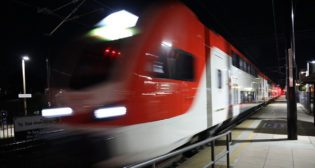
A framework for “meaningful mobility”
Written by Chip Kraft
Richard Anderson, Amtrak’s new President and CEO, has been bringing a “business approach” to intercity rail passenger service. Although the Northeast Corridor (NEC) has huge capital costs, Amtrak’s services in the NEC at least produce a positive operating cash flow, and state-supported services elsewhere at least break even. Anderson has correctly identified the long-distance passenger train network as a source of unfunded operating losses.
Amtrak has been cross-subsidizing long-distance train operating losses by using operating surpluses from the NEC. This cross-subsidy has drained financial resources from the NEC, while NEC capital support has mostly come from tax dollars that are taken from all 50 states. For example, some tax dollars from Colorado go to the NEC for capital support; Amtrak operates two long-distance trains through Colorado partially paid for by NEC operating surpluses.
In the U.S., high quality passenger rail services have mostly been confined to the Northeast, while the rest of the country is taxed to pay for their capital costs. Meanwhile, the rest of the country receives a level of rail passenger service that is sub-par based on any practical international comparison. The current skeletal network of once-a-day (or less) services currently offered by Amtrak serves many communities in the middle of the night, but a network of corridor trains (such as proposed for the Midwest U.S.) would actually provide meaningful mobility to the communities served.
The solution is not to end service to major regions of the country, thus exacerbating the inequities that already exist. Rather, corridors across the country should be raised to similar standards of passenger service as are already enjoyed in the NEC, for alleviating these inequities.
Europe and most other developed regions have over the years pursued a process of rail corridor development. They exploit the advantages of rail over the short to intermediate distance ranges where rail makes the most sense. As rail services improved and ridership grew, this naturally evolved to a point where commercial justification became apparent for construction of new high-speed rail lines on new alignments. By comparison, U.S. reliance on slow long-distance trains has never provided a jumping-off point that would logically evolve to a high-speed network.
Technical arguments supporting the economic case for rail corridor development were effectively laid out as early as 1997 in the Federal Railroad Administration’s Commercial Feasibility Study. This pioneering work developed a solid cost-benefit framework that has subsequently served as a model for rail planning in the Midwest and elsewhere.
In reality, the economic fundamentals have been supportive of rail corridor development in the U.S. for a long time. With increasing population, income and employment; rising energy prices and worsening traffic congestion, the opportunity for passenger rail today is better than ever before.
However, instead of promoting the economic case for corridor trains, rail advocates have tended to promote the social value of long-distance trains. These arguments have mostly resounded on one side of the political aisle (Democrats) but not on the other (Republicans), contributing to the polarization of what ought to be a bipartisan issue.
It is time for the economic arguments in favor of investment in rail corridor services to be more effectively articulated. The economic case for passenger rail corridor development is very strong, and the opportunity needs to be better understood not only by Congress, but also by Amtrak and the freight railroads.
In many areas, particularly across the eastern half of the U.S., long-distance trains could be replaced by a network of interconnected corridor services that could operate on an economically self-sustaining basis. Only a few Western long-distance trains would need to remain for bridging gaps between populated areas, thereby greatly reducing the federal subsidy burden over time, while actually improving services.
In the meantime, continuing to operate the existing network of long-distance trains preserves Amtrak’s statutory rights of access to infrastructure, and maintains the integrity of the existing passenger rail network. Existing long-distance trains serve a valuable “placeholder” function until rail corridor services can be implemented in the future. Discontinuing long-distance trains now would only make it much more difficult and expensive to implement future corridor services. As past discontinuances have shown, critical passenger infrastructure will likely be lost if services are even temporarily discontinued.
Amtrak should focus most of its energies on growing its corridor services, including corridors outside the NEC that can start to replace long-distance trains. This can be shown to have solid economic justification in cost-benefit and economic development terms. Meanwhile, Amtrak should continue to operate its existing trains to provide a bridge to that future. Over time, as corridor services are implemented around the country, long-distance trains can either be folded into those corridor operations or replaced by new services. This provides a pathway over time for Amtrak to eliminate its losses from long-distance trains, get its whole network onto a solid economic footing, and to finally remove the political Sword of Damocles that has been hanging over Amtrak ever since its creation.
The economic case for corridor development is very strong, so it would be a real tragedy if short-term service cuts were to undermine the ability to implement corridor improvements that are sorely needed across the entire country. If it wants to have a future, Amtrak’s focus should be on growing the network and on advocating for the funding that is necessary to do that, not on cutting existing services.

Chip Kraft
Dr. Edwin R “Chip” Kraft is Director of Operations Planning at Transportation Economics & Management Systems, Inc., Frederick, Md.



